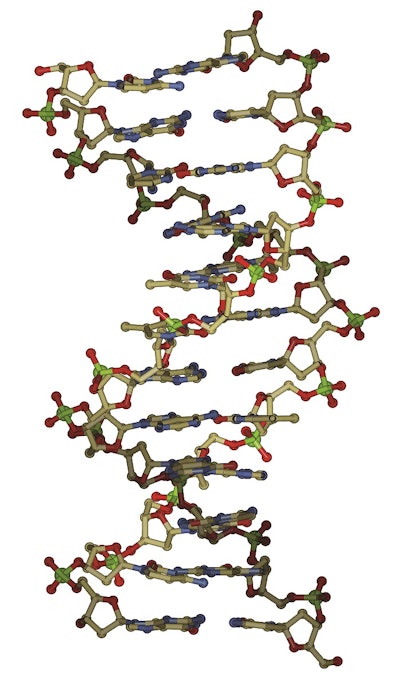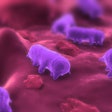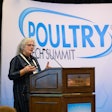
Whole genome sequencing can identify the unique fingerprint of foodborne pathogens found in poultry, meat and other food products, improving food safety for consumers and helping trace the source of outbreaks quickly.
“The structure of DNA was determined in 1953 by Watson, Crick and Franklin when the market weight of a broiler chicken was 2 pounds. The technology and poultry production have simultaneously expanded at an exponential rate,” said Grayson Walker, a combined DVM and Ph.D. student in Luke Borst’s laboratory at North Carolina State University’s College of Veterinary Medicine.
“Today, the market weight of a broiler chicken is nearly 10 pounds and we can obtain its entire genome sequence in a day or two.”
The laboratory procedure has revolutionized pathogen diagnostics, vaccine development and foodborne disease epidemiology.
“I’ve used whole genome sequencing to screen for virulence and antimicrobial resistance genes in E. coli and Salmonella isolated from poultry,” Grayson explained. “The possibilities are truly endless with this technology, especially in infectious disease and molecular epidemiology research.”
Bacterial fingerprint
Whole genome sequencing allows food safety experts to identify the DNA sequence of an organism quickly and efficiently. One of the biggest benefits of whole genome sequencing is its efficiency and specificity. Previous approaches for typing Salmonella and other pathogens relied on tedious molecular methods such as serological testing and pulsed-field gel electrophoresis.
Historically, food safety experts reacted retroactively to a foodborne illness outbreak. Because there was no way to know for sure how products were distributed, action only occurred once several cases of – or worse, deaths – attributed to an illness could be linked back to a region or product.
“Whole genome sequencing is an extremely powerful approach to ‘fingerprint’ bacterial isolates and to get detailed information on bacterial isolates,” Martin Wiedmann, food safety professor and a Cornell Institute for Food Systems faculty fellow, said.

This information can include the serotype of the bacteria, whether an isolate is antibiotic resistant and more.
Wiedmann’s lab has sequenced more than 2,000 bacterial isolates including Salmonella, Listeria and Bacillus cereus as well as organisms such as Pseudomonas or Bacillus species that cause spoilage.
“We are using whole genome sequencing both for our current research (for example: to understand why some Salmonella are more likely than others to cause human disease, or to understand how Listeria is transmitted in processing facilities), but also use it to help the industry solve acute food safety and spoilage issues,” he added.
The third leg of a three-legged stool
Food safety experts commonly refer to the components of an outbreak investigation as a “three-legged stool.” The first two legs are comprised of shoe leather epidemiology and actual traceback work.
“Whole genome sequencing can now provide the important third leg in the overall food safety investigative process. In fact, it has helped to give rise to a new term in the traceability of pathogens – ‘genomic epidemiology,’” explained Dr. Eric Brown, Director of the Division of Microbiology, Center for Food Safety and Applied Nutrition, Food and Drug Administration (FDA) - Office of Regulatory Science.
“The faster public health scientists and outbreak investigators can identify the source of a contamination event, the quicker the harmful ingredient can be removed from the food supply, reducing the number of illnesses and deaths.”
Outbreak investigations are the most common application for whole genome sequencing. The laboratory technique is used to compare the genomes of pathogens isolated from food samples, such as poultry products, to clinical samples obtained from sick patients. If a match between the two occurs, food safety experts can use this information to define the source and scope of a foodborne outbreak.
Beyond that, one of the greatest benefits of whole genome sequencing when it comes to outbreak investigation is the ability to match the genome sequence of a foodborne pathogen with its geographic origin.
“Genome sequences from pathogens within the same location will share more common features than from pathogens that are geographically spread out or originate from other parts of the world,” Brown added. “Knowing the geographic or regional variation of groups of pathogen genome sequences becomes particularly useful in tracking down the root source of contamination for multi-ingredient or complex foods whose raw ingredients can come from different states across the country or even from a variety of countries around the world.”
Sharing genomic data for quicker identification
In 2015, the FDA unveiled GenomeTrakr, a network of laboratories that shares genomic and geographic data from foodborne pathogens that was collected using whole genome sequencing.
The data, housed in public databases at the National Center for Biotechnology Information (NCBI), can be readily accessed by researchers and public health officials to slow foodborne illness outbreaks and reduce foodborne illnesses and deaths.
“To further strengthen the use of whole genome sequencing in such investigations, GenomeTrakr and their international partners, are building an international genomic network and database at NCBI’s Pathogen Detection for food safety laboratories to collect and use whole genome sequencing data and share their genomes publicly, to rapidly characterize pathogens for source tracking, public health and food security,” said Marc Allard, Ph.D., Research Microbiologist, Senior Advisor for Genomics, Center for Food Safety and Applied Nutrition, FDA.
“This ‘open data’ model allows for greater transparency between all stakeholders and fosters international collaborations," Allard continued. "Beyond outbreak and cluster detection, sharing high-resolution genomic data can be used by numerous independent public health entities that add value to what is publicly available."
Will consumers accept gene-edited poultry? WATTAgNet.com/articles/43348


















